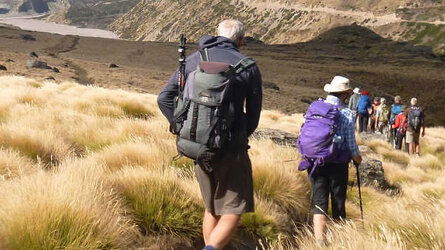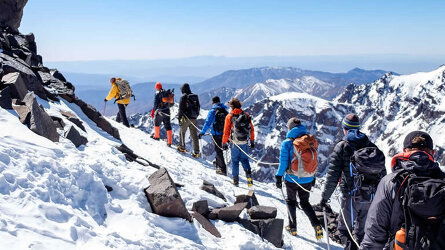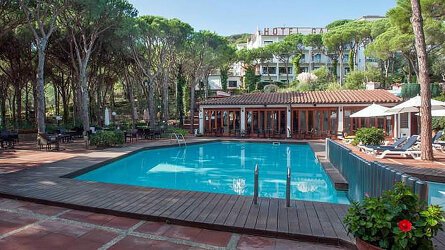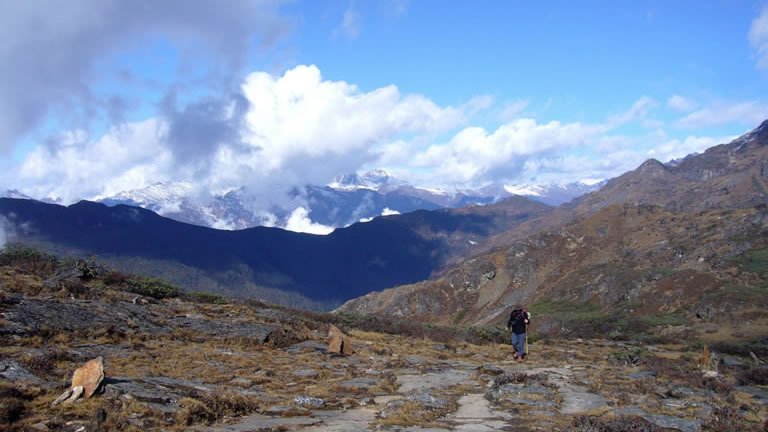Overview
Itinerary
The adventure begins in Kathmandu, the capital of Nepal. The evening is free to relax. If you have time, you may wish to explore the nearby buzzy Thamel district. Stay: Royal Singi Hotel (or similar).
We fly to Paro today. If the weather is clear, we should get a fantastic view (from the left-hand side of the plane) of much of the eastern half of the Himalaya, including Everest, Nuptse, Lhotse, Makalu, Kanchenjunga and Chomolhari (Jhomolhari). After completing visa formalities in Paro, we transfer to our hotel. The Paro Valley is considered one of the most beautiful in Bhutan with blue pine-covered hills and attractive farmhouses among paddy fields – all dominated by the massive dzong (fort).
This afternoon, we aim to visit Paro Dzong and the national museum above it. Paro Dzong is one of the most impressive in Bhutan, and the finest example of Bhutanese architecture you will see. The inward-sloping walls form a massive structure that towers over the town. Built in the 17th century, it was one of the strongest and most important fortresses in Bhutan and was used on several occasions to defend the Paro Valley from invasions by Tibet. Formally the meeting hall for the national assembly, the dzong now houses a monastic school and district government offices.
West of the dzong is a covered wooden bridge named Nyamal Zam, a reconstruction of the original bridge, which was washed away in a flood in 1969. At the top of the hill, above the dzong, is the old watchtower known locally as Ta Dzong. Originally built in 1656, it was renovated in 1968 by King Jigme Dorje Wangchuk to house the National Museum. Damaged by the earthquake in 2011, the museum is now in a new building above the Ta Dzong. Inside the museum, there are collections of masks and thangkas (Tibetan Buddhist paintings). Please note, the itinerary above could change subject to flight timings, which are generally unpredictable. Stay: Rema Resorts (or similar) (B/L/D).
Today we have a warm-up hike to Taktsang Monastery. Also known as the Tiger's Nest Monastery, it is perched on the ledge of a cliff high above the Paro Valley. Partly destroyed by fire in 1998, it has now been completely restored to its former magnificence. We drive a short distance from the hotel and then hike up for about 1hr 30min to a viewpoint for classic views of the monastic buildings that cling impossibly to the cliff wall opposite. If you're feeling energetic, walk another 45 minutes to the actual monastery.
The walk is good for acclimatisation and we recommend you wear trekking boots. Please note, there about 100 steps up and down. Returning to the hotel, we have time in the afternoon to explore Paro town. Stay: Rema Resorts (or similar).
Today we start our trek. After breakfast, we have a short drive to about 8,595ft (2,620m), just above the ancient Ta Dzong watchtower. The first day's trekking is not long in terms of hours but it's uphill all the way and we gain quite a lot of height. From our start point, it is a gentle climb for about 1hr 30min on a jeep track to a prayer wall.
The trail then narrows and we continue climbing on a rocky path (a little steeper now) through the forest. We have lunch in a clearing about an hour further on and then it's about an hour's walk in the afternoon to the Jele La (11,645ft/3,550m) and our camp just below the pass and Jele Dzong. If the weather is clear, we can see the Paro Valley below. If you're still keen to walk, trek further up the ridge from the Jele La to a ruined shepherd hut with a small Bon shrine inside. Stay: Full-service camping (sleeping altitude: 11,580ft/3,530m) (B/L/D).
After breakfast, we walk five minutes back up to the main trail and continue climbing for about 30 minutes to Jele Dzong. If it is open, we can go inside the 14th-century dzong. Continuing up the ridge for a short way, we can see the Paro Valley way below and, if the weather is clear, we may even spot the peak of Chomolhari in the distance. The trail undulates through thick rhododendron forests this morning – keep your eyes peeled for colourful monal and blood pheasants.
Lunch is in a forest clearing and we have a short walk in the afternoon to our camp at Rawna. Please note, if there are other trekking groups around, we may have to camp at Jangchu Lakha (12,140ft/3,700m) or Tsokam (12,300ft/3,750m). All three campsites are close by, each in different forest clearings. Stay: Full-service camping (sleeping altitude: 12,665ft/3,860m) (B/L/D).
It's a long day today and probably the hardest walk of the trek. We climb steeply from camp on a narrow trail for about an hour to rejoin the main trail. We continue climbing through a rocky landscape littered with small rhododendron bushes. We reach a col at 13,367ft (4,073m) marked with prayer flags and then drop down a short way to a cave.
The trail then climbs again quite steeply to a ridge at 13,385ft (4,080m), where we get spectacular mountain views on a clear day, including Chomolhari and Jichudrake. We have lunch on the ridge while enjoying the views and then continue a little further up the ridge to 13,520ft (4,120m). From here, we contour round a little and then drop steeply on a rocky trail to the shores of Jimi Lang Tscho, well known for its trout. Stay: Full-service camping (sleeping altitude: 12,746ft/3,885m) (B/L/D).
We have another long but great day's walk with good mountain views. The trail climbs from camp along a rocky trail up to Janye Tscho Lake. Climbing even higher to a col at 13,615ft (4,150m), we then have a short descent to Simthokha Lake (13,420ft/4,090m), the highest lake on our trek. From here, the trail undulates all the way to our camp at Labana. Stay: Full-service camping (sleeping altitude: 13,450ft/4,100m) (B/L/D).
The trail climbs gradually up to the Labana Pass, the highest point of this trek at 13,895ft (4,235m). The views get better and better and, on a clear day, we can see Gangar Punsum, Table Mountain and much of the Bhutan Himalaya. Way below is the Thimphu Valley. From the top, we traverse the hillside with great mountain views and descend towards Thimphu. There are a couple of small climbs to cols but the general direction is downhill. From the Phajoding Labsa chorten (shrine), we descend quite steeply to Phajoding Monastery for lunch.
There are several temples here and a monastic school and the place is visited by many Bhutanese. We descend even further through forests of blue pine to the end of our trek at Motithang, just above Thimphu, the capital of Bhutan. We should reach our hotel by mid-afternoon. The evening is free to explore Thimphu. Stay: Hotel Gakyil (or similar) (B/L/D).
We spend the day visiting the most important sites in and around Thimphu, including the Memorial Chorten (built in 1974 to honour the memory of the third king, Jigme Dorji Wangchuk) and Buddha Point (a large Buddha statue on the hillside overlooking Thimphu). There are several museums in Thimphu and an art school, while the post office and market are also interesting. Above the town is a takin preserve. Your leader aims to show you as much as possible in the time available depending on opening times. Alternative itinerary for festival departures: Thimphu/Dechenphug Tshechu Festival – October and November 2025/2026.
We spend the whole day experiencing one of the many vibrant festivals in Bhutan. During the festivals, the Bhutanese gather to see the monks and lay dancers dressed in colourful brocade and silk costumes, wearing painted masks re-enacting the stories of the religious and lay history of Bhutan through music and dance. For several days, there are masked dances, prayer meetings, and a carnival atmosphere as many villagers arrive to meet old friends. The Bhutanese all wear their finest national dress for the festival and one of the highlights is the magnificently colourful silks on display. Paro and Thimphu are the most popular festivals in Bhutan whereas Dechenphug Tshechu is much smaller. Stay: Hotel Gakyil (or similar) For Paro Festival departures (2 April 2025 and March 2026), our accommodation is Rema Resorts (or similar) (B/L/D).
Depart for Paro after breakfast (one-hour drive), visiting Kyichu Lhakhang en route. Built in the seventh century, it is said to be the oldest temple in Bhutan and therefore holds great spiritual significance to the country. Legend says it was built on the foot of an ogre by a king in one night. After this, we continue to explore the city and surrounding area.
Alternative itinerary for festival departures: Paro Festival – 2 April 2025 and March 2026 We travel to Paro late afternoon on Day 9, so we're ready for an early start today experiencing the festivities as described on Day 9. Stay: Rema Resorts (or similar) (B/L/D).
We fly back to Kathmandu. The rest of the day is free to explore the temples and markets of the Nepalese capital or go shopping. There are several sightseeing tours available (ask the Exodus representative in Kathmandu) or you may want to explore on your own. You could visit the monkey temple at Swayambhunath, the largest Hindu temple in Nepal at Pashupatinath, or one of the largest Buddhist stupas in Asia at Boudhanath. Once you've had your fill of culture, the colourful markets of Thamel are great for souvenir hunting. Stay: Royal Singi Hotel (or similar) (B).
Our trip ends in Kathmandu after breakfast. If you'd like more time to explore, speak to your sales representative about extending your stay. Sometimes, due to opening times, holidays or festivals, we have to change the timings of the sightseeing around. We endeavour to show you all the sights in the time available. In case it is not possible to visit any of the sights described in the notes above an alternative will be provided (B).
Trip Inclusions
- Embark on a short classic trek through the beautiful Bhutanese countryside
- Gain an insight into the local way of life
- Visit cultural highlights including Dzong in Paro and the Memorial Chorten in Thimpu
- Witness Bhutan's colourful, vibrant festivals (on festival departures)
- Visit the incredible Taktsang Tiger's Nest Monastery
- 7 Classic nights (hotels), 4 Simple nights (full-service camping)
- Five days of point-to-point walking with full porterage, plus one daywalk
- Travel by private minibus
- Paro and Thimphu festival departures available (see Dates & Prices for details)
- All breakfasts, nine lunches, nine dinners
- All transport and listed activities
- Tour leader throughout
- Free arrival and departure transfers for everyone
- Bhutanese visa
- Itinerary and inclusions are subject to change
- Price is for land, cruise and internal flights as specified. Flights not specified are not included
- Altitude maximum: 13,894ft (4,235m); average: 11,988ft (3,654m)

Hit the trails with Exodus - from challenging peaks to leisurely coastal and countryside walks. Read more

Exodus chooses their Leaders carefully. Professional, dedicated and are passionate about sharing their home countries. Read more

Wherever possible, Exodus chooses properties that are locally owned and that reflect the area you are visiting. Read more
Availability
A definite departure means minimum numbers have been reached for this departure to operate. Your Global Journeys Travel Advisor will check the availability of your departure date when you enquire. Additional savings may apply. We guarantee the lowest price in Australia. T&C’s apply.
Tour & cruises prices are per person. Prices shown have savings applied, are subject to availability and may be withdrawn at any time without notice. Pricing and trip details are correct at this point in time, however are subject to confirmation at the time of booking and are subject to change by Exodus. For cruise itineraries, cabin images are sourced from Exodus. These should be treated as indicative only. Cabin inclusions, upholsteries and room layout may differ to the image(s) shown depending on the ship selected and your sailing dates.









